Last Chance: The Annual Orchid Show Soars at the New York Botanical Garden
The vibrant colors of Mexico come to NYC for a unique Orchid Show at NYBG!


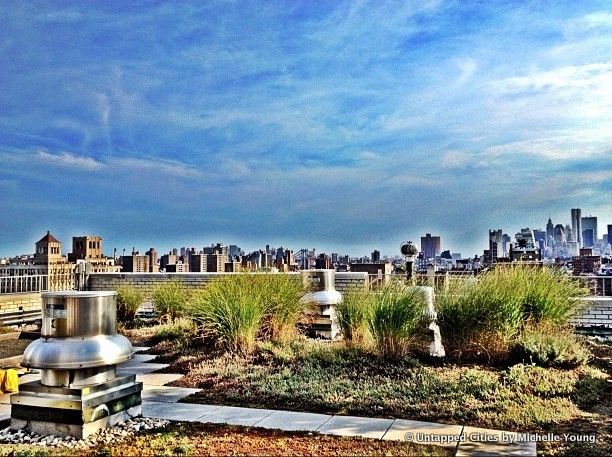
Walking through cavernous Manhattan in 2012, you might see something quite unexpected when you gaze up: exotic plants and flowers creeping over the parapet of buildings. This most certainly would have been a strange sight 100 years ago, I think it would have been strange even 15 years ago, but right now a green roof movement is sweeping across New York and the country. Trees growing out of buildings are no longer signs of neglect, but a reflection of the most cutting edge technology in sustainable design and high-end amenities.
To get a better idea of what green roofs are and do, we toured a roof in the East Village with Christian Toebe of Greensulate, a company specializing in green roof design and construction. The building he showed us was a private co-op, one where the board decided opted to go green and provide roof access for tenants, instead of paying for a regular roof fix. Exiting the staircase to the roof we were surprised to find a quiet patio and garden, where residents can escape to relax, read or play bocce.

This particular design that Christian showed us was a mixture of extensive and intensive garden design, the difference is the degree of maintenance that is required. About half the roof was roped off flat surfaces covered in sedum that requires almost no maintenance (extensive), while the other half contained grasses, flowers, a patio and a small bocee court (intensive). Green roof designers work with building owners to find out what type of roof is desired, and then work with them to create a space that will boost property values and extend the roof’s life. This roof was a good example because it shows a range of what is possible on a typical, flat New York City roof.


The basic plant used in most green roofs is sedum, a plant that both grows well in the planting medium chosen and with little water, about 2.5 centimeters needed a month. This is a basic plant that helps the roof reach its desired colored and is usually preferred to grasses since it provides all the same benefits but does not require mowing. There are over 250 types of sedum, and about 15 were chosen for this roof. The sedum is grown in a planting medium that consists of about 80% aggregate and 20% compost. This type of medium is chosen since it is lighter than soil.
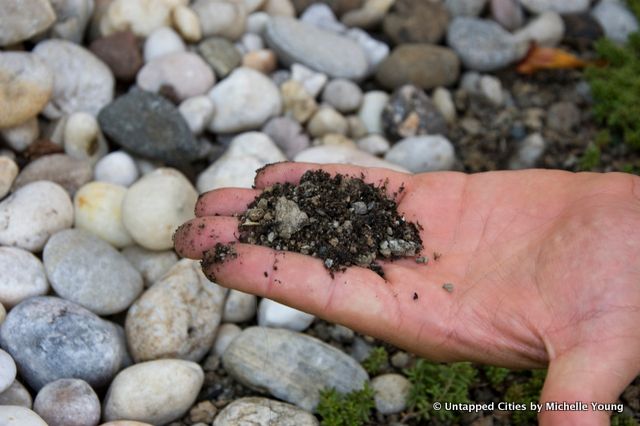
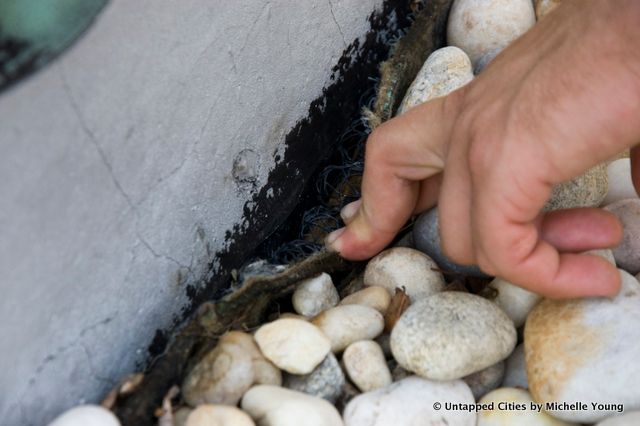
Beneath the soil are a series of layers that include a filter fleece layer, a drainage layer, and finally a waterproof membrane that acts as the main divider between the roof and the organic material. Although seemingly complex, the installation of this roof took only 5 days. Design of the roof and approvals can take a long time, but once finalized the installation team can quickly put it together. The more money spent upfront on a good design, the better the ultimate outcome.
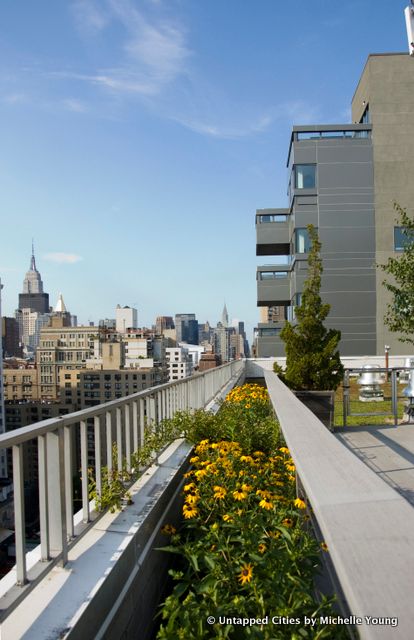
Looking through the photos you can see how the plantings provide both an aesthetic boost to the building, while blending in seamlessly with the functioning machinery of the building. Aesthetics are not just the only goal of green roofs, a good design helps balance the weight of the plantings, and allowing proper drainage to occur so that heavy rain does not collapse the roof. The varieties of plants chosen can yield different benefits, with some chosen for attracting and providing cover for migrating birds or native insects.
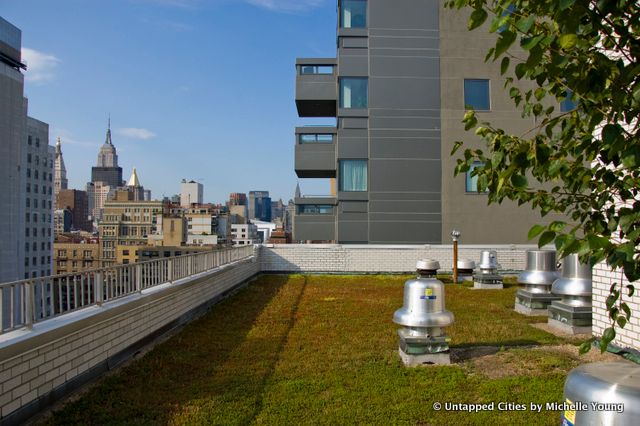
We visited during a drought period mid-summer, but this area recovers quickly with just a little rainfall
The standard benefits of a green roof, including reduction of building temperature and reflection of the sun’s rays, are very similar to that of the °CoolRoofs Untapped New York explored previously. With the addition of organic plantings, oxygen is created. In contrast to white roofs, green roofs can use the rainfall through evapotranspiration and help divert rainwater from entering New York City’s combined sewer overflows (CSOs) which pollute the waterways during storms. Stormwater management is a major focus on the City’s PlaNYC 2030 sustainable goals. Christian explained that this roof can soak up the first hour of a typical rainfall, which can remove thousands of gallons of water from our sewers. The roof can also slow the entry of water into the city’s sewers, allowing for it to miss peak times when the most damage can be done.

What I found as the most surprising benefit of green roof design is its ability to dampen sound. Christian mentioned a study that has shown that green roofs can help buildings mitigate the heavy noise present near airports, dropping about 35 decibels of the amount of sound that penetrates the building. This means the benefits can be more functional rather than just environmental.
What incentivizes cities to encourage this movement are the Clean Water and Clean Air Acts. Cities can be charged big bucks for allowing stormwater runoff to pollute rivers, so using policy to create incentives for cleaner, greener roofs can pay off in the end. New York is not the first city that has participated in this movement. Chicago was an earlier pioneer of the practice. With improvements in design, technology, and research, roof life can be extended to 50 years years by using green roofs, Christian believes.

The view residents can now enjoy through roof access.
This spring, New York City’s Department of City Planning adopted Zone Green which eases the restrictions and requirements for approval of green roofs. An increase property values while supporting sustainable goals makes the green roof a win-win-win situation (the third win for the bocce court on this roof).Across the United States, cities like New York, Boston and Chicago are filling in, and the majority of the large vacant parcels are being bought up and built up. Roofs provide one of the last frontiers for great urban design. This entire movement, and the possible benefits that occur, have created a whole new conversation between both those in the architecture and design industry and those in biology and environmental science. Since we are still at an early point of green roof architecture, it is an exciting time to see the cooperation between these two disciplines.

Bocce ball court
Subscribe to our newsletter